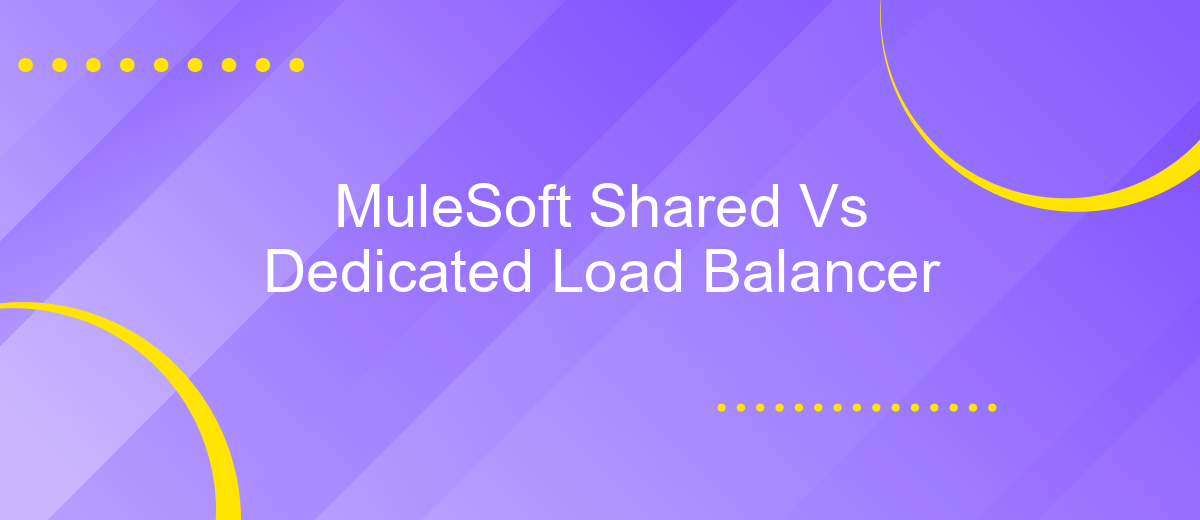MuleSoft Shared Vs Dedicated Load Balancer
When integrating applications and managing APIs, choosing the right load balancer is crucial for performance and reliability. MuleSoft offers two main types of load balancers: Shared and Dedicated. Understanding the differences between these options can help you make an informed decision, ensuring optimal resource allocation and seamless traffic management for your enterprise needs.
Introduction
When it comes to optimizing your MuleSoft environment, choosing the right load balancer is crucial. MuleSoft offers two main types of load balancers: Shared Load Balancer and Dedicated Load Balancer. Each has its own set of features and advantages, catering to different business needs and technical requirements.
- Shared Load Balancer: Ideal for smaller projects or environments with moderate traffic.
- Dedicated Load Balancer: Suited for larger enterprises requiring high availability and performance.
Understanding the differences between these two options can significantly impact your system's efficiency and reliability. Additionally, integrating with services like ApiX-Drive can streamline your operations by automating data transfers and enhancing connectivity across various platforms. This article aims to provide a comprehensive comparison to help you make an informed decision.
Shared Load Balancer

The Shared Load Balancer (SLB) in MuleSoft is a cost-effective solution for distributing incoming traffic across multiple Mule applications. It operates at the HTTP level and is managed by MuleSoft, ensuring high availability and fault tolerance without requiring extensive configuration. This makes it an ideal choice for organizations looking to optimize resource usage while maintaining robust performance. The SLB automatically scales to handle varying traffic loads, providing a seamless experience for end-users without the need for manual intervention.
One of the key advantages of using a Shared Load Balancer is its integration capabilities. For instance, when setting up integrations via services like ApiX-Drive, the SLB can efficiently manage and balance the load across different endpoints, ensuring consistent and reliable data flow. This is particularly beneficial for businesses that rely on multiple third-party applications, as it simplifies the integration process and enhances overall system stability. By leveraging the SLB, organizations can achieve a streamlined, scalable, and cost-effective solution for their integration needs.
Dedicated Load Balancer

Dedicated Load Balancers (DLBs) offer enhanced control and customization for managing traffic within your MuleSoft environment. Unlike shared load balancers, DLBs are exclusively allocated to a single organization, providing improved security and performance.
- Enhanced Security: DLBs isolate your traffic from other organizations, reducing the risk of data breaches.
- Custom Configuration: Allows for tailored settings to meet specific needs, such as custom SSL certificates and advanced routing rules.
- Improved Performance: With dedicated resources, DLBs can handle higher traffic volumes and provide better response times.
For businesses requiring complex integrations, services like ApiX-Drive can be invaluable. ApiX-Drive simplifies the process of connecting various applications and automating workflows, ensuring seamless data flow across your systems. By using a dedicated load balancer in conjunction with ApiX-Drive, organizations can achieve robust, secure, and high-performing integration solutions tailored to their unique requirements.
Comparison of Shared Vs. Dedicated Load Balancers

When deciding between MuleSoft's Shared and Dedicated Load Balancers, it's crucial to understand their differences to make an informed choice. Shared Load Balancers are cost-effective and managed by MuleSoft, making them ideal for small to medium-sized businesses. They offer basic load balancing capabilities and are easy to set up, requiring minimal maintenance from the user's side.
In contrast, Dedicated Load Balancers provide enhanced performance and greater control. They are suitable for larger enterprises with high traffic and specific security requirements. Dedicated Load Balancers allow for custom configurations and offer advanced features such as SSL termination, IP whitelisting, and detailed logging.
- Cost: Shared Load Balancer is more affordable, while Dedicated Load Balancer incurs higher costs.
- Control: Shared is managed by MuleSoft, Dedicated offers full user control.
- Performance: Shared is suitable for moderate traffic, Dedicated handles high traffic efficiently.
- Security: Shared has standard security, Dedicated provides enhanced security features.
Choosing the right load balancer depends on your specific needs. For seamless integration and automation, consider using services like ApiX-Drive, which can help streamline your processes and ensure efficient data flow between systems, complementing your load balancing strategy.
Conclusion
Choosing between a shared and dedicated load balancer in MuleSoft depends on your specific needs and use cases. Shared load balancers are cost-effective and suitable for smaller applications with moderate traffic. They offer ease of setup and maintenance, making them ideal for businesses that do not require extensive customization or advanced features.
On the other hand, dedicated load balancers provide greater control, enhanced performance, and improved security. They are essential for larger enterprises with high traffic volumes and complex integration requirements. For those looking to streamline their integration processes further, leveraging services like ApiX-Drive can be beneficial. ApiX-Drive offers automated integrations and simplifies the management of multiple APIs, ensuring seamless connectivity and efficient data flow. Ultimately, the choice between shared and dedicated load balancers should align with your organization's scalability, security, and performance needs.
FAQ
What is the primary difference between a Shared Load Balancer and a Dedicated Load Balancer in MuleSoft?
When should I consider using a Dedicated Load Balancer over a Shared Load Balancer?
Are there any cost implications when choosing between Shared and Dedicated Load Balancers in MuleSoft?
Can I switch from a Shared Load Balancer to a Dedicated Load Balancer later on?
How do load balancers affect the performance of my MuleSoft integrations?
Strive to take your business to the next level, achieve your goals faster and more efficiently? Apix-Drive is your reliable assistant for these tasks. An online service and application connector will help you automate key business processes and get rid of the routine. You and your employees will free up time for important core tasks. Try Apix-Drive features for free to see the effectiveness of the online connector for yourself.

